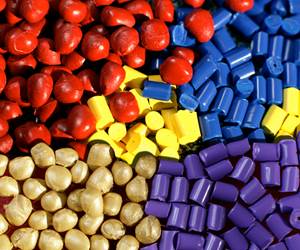Single-Screw Mixing 101
Almost all processes using a single screw require some degree of mixing, whether it’s just to homogenize regrind with virgin resin or to mix in some color concentrate.
Almost all processes using a single screw require some degree of mixing, whether it’s just to homogenize regrind with virgin resin or to mix in some color concentrate. Although there have been many presentations on mixing by experts over the years, processors often find it complicated to apply this information to their own requirements. Many processors also confuse poor melting with poor mixing. Most polymers and additives cannot be effectively mixed until everything that can be melted is melted. As a result, melting and mixing often must be dealt with in the same screw design, although the solutions are often not the same.
There are three kinds of mixing: dispersive, distributive, and extensional. We will deal here only with dispersive and distributive mixing, as extensional mixing occurs predominantly in twin-screw extruders. Dispersive mixing is like putting two materials to be mixed between two plates and rotating one of the plates. The shear stress developed in the polymer between the plates would be proportional to the distance between the plates and the speed at which the plate was rotated.
Distributive mixing is like putting the two materials in a bowl and stirring them with a spoon. The number and path of the spoon strokes would be proportional to the degree of mixing.
Screws inherently provide both dispersive and distributive mixing. Generally, the shallower the screw the more dispersive mixing occurs, and the more disruptions in the flow path the more distributive mixing occurs.
A worn screw actually makes an excellent mixer. As the polymer leakage over the flights increases with increasing barrel/screw clearance, both dispersive and distributive mixing increase significantly. Increased dispersive mixing occurs as the polymer and additives pass through the narrow gap between the screw flight and barrel, where the shear stress is very high. Distributive mixing occurs as the polymer leaking over the flights is continuously blended into the polymer in the adjacent channels. I have heard many times about a processor putting in a new or rebuilt screw and finding that mixing quality has been reduced. Naturally, this was blamed on whoever built or repaired the screw. Worn screws would be an easy solution to many mixing problems, but the downside is you get decreased output from them.
In order to maintain output and accomplish the required mixing, screw designers have created a wide variety of mixing devices. No one mixer fits all situations, so it is important to determine exactly what your overall process requirements are before selecting a mixer or even a combination of mixers.
Dispersive mixing applies force to the materials and thus requires drive energy that ends up in the polymer mix to help melt it and/or raise its temperature. Consequently, dispersive mixing assists or adds to the melting capacity of the screw. In addition, its tight clearances often function as a “dam,” restricting unmelted polymer from passing through until reduced in size or melted. Many screw designs would discharge unmelted polymer at almost all speeds without a dispersive mixer. The “Maddock” mixer is a very popular example of a mixer that is primarily dispersive, with lesser distributive characteristics.
Although distributive mixing also requires some drive power, it is generally small enough to have a very minor effect on the melt temperature. A “Saxton” style mixer is an example of a mixer that is mostly distributive with minor dispersive characteristics.
A mixer combining strong dispersive and distributive characteristics is called the “Egan” style mixer. All of the flights are undercut so there is a lot more dispersive and distributive mixing than with the Maddock mixing section.
The mixers mentioned here are only for illustration of the principles and are not necessarily the only recommended designs. Like many things in polymer processing, there is no single answer to the mixing issue, and you may want to consult someone knowledgeable about this subject. The objective here is to give you some background to help evaluate your situation.
About the Author
Jim Frankland is a mechanical engineer who has been involved in all types of extrusion processing for more than 40 years. He is now president of Frankland Plastics Consulting, LLC. Contact jim.frankland@comcast.net or (724) 651-9196.
Related Content
A Systematic Approach to Process Development
The path to a no-baby-sitting injection molding process is paved with data and can be found by following certain steps.
Read MoreProcess Monitoring or Production Monitoring — Why Not Both?
Molders looking to both monitor an injection molding process effectively and manage production can definitely do both with tools available today, but the question is how best to tackle these twin challenges.
Read MoreFundamentals of Polyethylene – Part 6: PE Performance
Don’t assume you know everything there is to know about PE because it’s been around so long. Here is yet another example of how the performance of PE is influenced by molecular weight and density.
Read MoreInjection Molding: Focus on these Seven Areas to Set a Preventive Maintenance Schedule
Performing fundamental maintenance inspections frequently assures press longevity and process stability. Here’s a checklist to help you stay on top of seven key systems.
Read MoreRead Next
See Recyclers Close the Loop on Trade Show Production Scrap at NPE2024
A collaboration between show organizer PLASTICS, recycler CPR and size reduction experts WEIMA and Conair recovered and recycled all production scrap at NPE2024.
Read MoreBeyond Prototypes: 8 Ways the Plastics Industry Is Using 3D Printing
Plastics processors are finding applications for 3D printing around the plant and across the supply chain. Here are 8 examples to look for at NPE2024.
Read MoreMaking the Circular Economy a Reality
Driven by brand owner demands and new worldwide legislation, the entire supply chain is working toward the shift to circularity, with some evidence the circular economy has already begun.
Read More.jpg;width=70;height=70;mode=crop)













